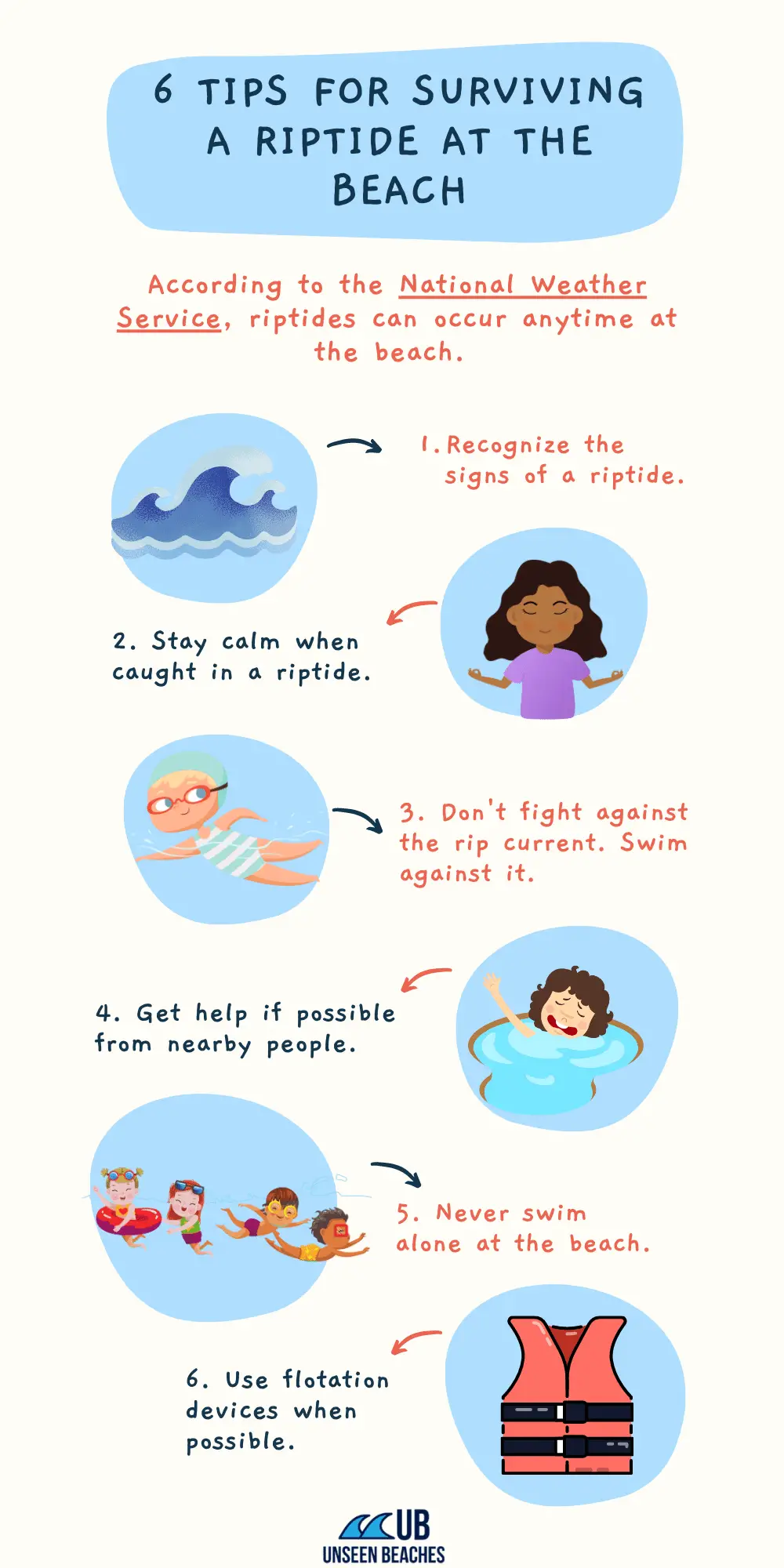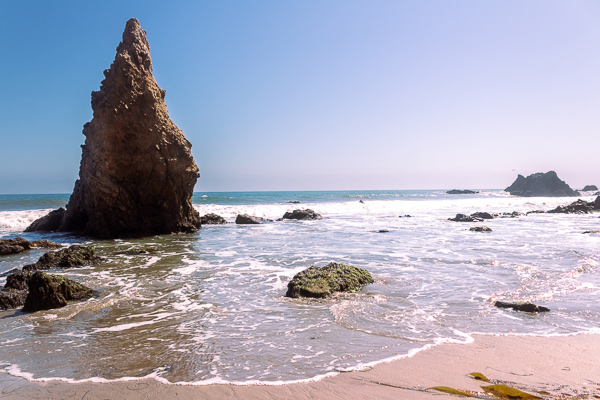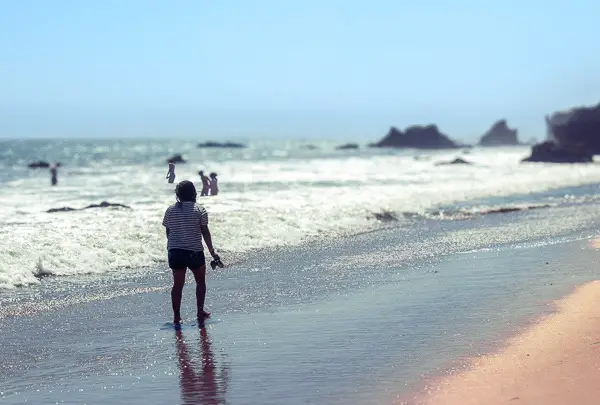When it comes to beach safety, understanding how to survive a riptide is crucial.
Riptides, often complicated with rip currents, are powerful currents that can occur along the shoreline and pose a significant risk to swimmers.
In this post well well explore what exactly is a riptide and most importantly six vital things every beachgoer should know to survive a riptide.
By being aware of these essential tips, you can be better prepared to handle a riptide situation and ensure your safety at the beach.
Overview:
- What is a Riptide?
- Riptide vs. Rip current
- How to Survive a Riptide: 6 Vital Things Worth Knowing
- F.A.Q.s
- Conclusion
This post contains affiliate links. This means that if you decide to click and buy something we may receive a small commission (at NO additional cost to you!) See my affiliate disclosure here.
What is a Riptide?
“A rip tide, or riptide, is a strong offshore current that is caused by the tide pulling water through an inlet along a barrier beach, at a lagoon or inland marina where tide water flows steadily out to sea during ebb tide… “
Wikipedia
Riptides can vary in size and strength and sometimes catch swimmers off guard.
They are commonly mistaken for rip currents, but they are not the same.
Riptides are usually found in coastal areas with breaking waves, and they can be challenging to detect with the naked eye.

Understanding the characteristics of a riptide and knowing how to identify one is the first step in surviving this potentially dangerous situation.
Riptide vs Rip Current

While riptides and rip currents are often used interchangeably, they are technically different phenomena.
Rip currents are fast-moving channels of water that flow perpendicular to the shore, while riptides are more like a river of water flowing away from the shore.
Rip currents are typically caused by the water that has piled up on the shore from breaking waves, and they can extend from the shoreline to hundreds of feet offshore.
Rip currents are typically caused by the water that has piled up on the shore from breaking waves, and they can extend from the shoreline to hundreds of feet offshore.
On the other hand, riptides are caused by the interaction of different currents and the shape of the coastline.
To better understand the differences between riptides and rip currents, let’s take a look at the following comparable table:
| Riptides | Rip Currents |
|---|---|
| Flow away from the shore | Flow perpendicular to the shore |
| More like a river of water | Fast-moving channel of water |
| Can be harder to detect | Can be easier to detect |
| Typically found in coastal areas with breaking waves | Can occur in any coastal area |
| depth water (over 3 meters) | narrow water (3-6 feet) |
By understanding these differences, you can be better equipped to identify and respond to a riptide or rip current situation, and take appropriate actions to ensure your safety.
How to Survive a Riptide: 6 Vital Things Worth Knowing

Knowing how to survive a riptide is crucial for beach safety.
Riptide can be powerful and dangerous, but with the right knowledge and actions, you can increase your chances of escaping safely.
Here are six vital things worth knowing to survive a riptide.
1. Recognize the Signs of a Riptide
Recognizing the signs of a riptide is the first step in staying safe.
Riptides are often characterized by a noticeable difference in water color, choppier waves, or an area of water that appears to be moving faster than the surrounding water.
Additionally, riptides may also have a sandy or murky appearance due to the water and debris being pulled out to sea.
It’s crucial to pay attention to any warning signs or flags posted on the beach and heed the advice of lifeguards or local authorities.
Being able to identify the signs of a riptide can help you avoid entering the dangerous area in the first place and prevent a potentially life-threatening situation.
2. Don’t Panic and Remain Calm
Remaining calm is essential when caught in riptides.
Panicking can lead to exhaustion and poor decision-making, which can increase the risk of drowning.
It’s crucial to stay calm, keep your head above water, and remember that rip currents are typically not very wide.
Avoid trying to swim directly back to the shore against the current, as this can quickly tire you out.
Instead, float or tread water, and conserve your energy.
By staying calm, you can think clearly and focus on the necessary steps to escape the riptide safely.
3. Don’t Fight the Current (e.g., Swim Parallel to the Shoreline)
Fighting against the rip current is not effective and can lead to exhaustion.
The current is often too strong to swim directly against, and it’s essential to avoid this instinctive reaction.
Professional lifeguards are always recommended instead of swimming parallel to the shore, either left or right, which is the most effective way to escape the riptides.
Once you are out of the tides, you can swim towards the shore at an angle.
It’s important to remember that riptides are typically narrow, so swimming parallel to the shoreline is the best approach to break free from the current and make your way back to safety.
4. Call for Help if Possible
If you’re unable to escape the rip current on your own, it’s crucial to call for help if possible.
Signal for assistance by waving your arms, shouting for help, or using a whistle if you have one.
If there are other people on the beach or in the water, try to attract their attention.
If you have a phone or any other means of communication, use it to call for help.
Remember that it’s okay to ask for assistance when needed, and seeking help can be a critical step in surviving a riptide.
5. Never Swim Alone

Swimming alone in the ocean is never recommended, especially in areas prone to riptides.
Always swim with a buddy or in the presence of a lifeguard if possible.
Having someone with you can provide additional support and assistance in case of an emergency.
If you’re not a confident swimmer or unfamiliar with the ocean, it’s even more important to swim with a companion.
A buddy can help you stay safe and alert to potential dangers, including rip currents and tides.
Remember, swimming with a buddy is a simple yet effective precaution that can greatly reduce the risks associated with rip currents.
6. Swim with Flotation Devices if Possible

Swimming with flotation devices, such as life jackets or other flotation devices, can greatly increase your chances of surviving riptides.
We recommend going for the ONYX M-16 Belt Pack Manual Inflatable Life Jacket (PFD).
This inflatable life jacket is built around a belt pack that is lightweight and hardly visible when swimming in water.
It features an easy one-pull motion for a quick inflation process in case of an emergency.
Having flotation devices when caught in a riptide can provide additional buoyancy to help you stay afloat or conserve your energy.
This becomes vital especially if you’re not a strong swimmer.
Remember, the ocean can be unpredictable, and rip currents are powerful and dangerous.
By following these vital tips, you can increase your chances of surviving a rip current and enjoying a safe beach experience.
Frequently Asked Questions (F.A.Q.s):

How do you escape a rip current?
Escaping a rip current requires remaining calm and following the right steps.
When caught in a rip current, it’s crucial to avoid panicking and trying to swim directly back to the shore, as this can exhaust you.
Instead, swim parallel to the shore, either left or right, to get out of the current.
Once out, swim towards the shore at an angle, not against the current.
If you’re unable to swim out, float or tread water and signal for help. As rip currents are narrow, so swimming parallel to the shore is the key to escape.
Is it hard to escape a riptide?
Escaping a riptide can be challenging due to the strong current pulling you toward open water. The force of the current can be overwhelming, and it’s easy to panic.
However, staying calm is critical.
Remember those rip currents are typically not very wide, so swimming to the shore can help you escape.
It’s important to avoid exhausting yourself by swimming against the current, as this can lead to fatigue and increase the risk of drowning.
By remaining calm, following the right steps, and seeking help if needed, you can improve your chances of escaping a riptide successfully.
How far can a rip current take you?
Rip currents can vary in strength and speed, but on average, they can carry swimmers about 100-300 feet offshore. In some cases, they may extend even farther.
It’s crucial to be aware of this when swimming in the ocean and to take appropriate precautions to avoid getting caught in a rip current.
Always pay attention to warning signs and flags on the beach, and if you’re unsure about the conditions, ask a lifeguard or local authorities for advice.
Sometimes a little unconsciousness can fall you in danger, look for the sign and warning whether the forecasting riptide problems or not.
Knowing the potential distance a rip current can take can help you better understand the danger and take necessary precautions.
How do you not drown in a riptide?
To avoid drowning in a rip current, it’s vital to remain calm and not waste too much energy.
However, Panic can also lead to exhaustion and poor decision-making.
Remember to stay afloat by floating or treading water, and signal for help if you’re unable to swim out of the current.
A Parallel angle of swimming to the shore, is the best approach to get out of the current. Avoid swimming directly against the current, as this can quickly tire you out.
Using flotation devices, such as life jackets, can also aid in staying afloat and conserving energy.
Always prioritize your safety and seek help if needed to avoid drowning in a riptide.
What should I do if I see someone else caught in a riptide?
If you see someone caught in a riptide, it’s important to act quickly and responsibly to assist them without putting yourself in danger.
Here are some steps you can take:
| Don’t attempt to swim directly or tow the individual caught within the riptide – unless you are a trained professional. |
| Call for help – wave or shout to get attention from others such as lifeguards. |
| If you have a flotation device nearby throw it towards the individual caught in the riptide. |
| Once the individual is safe or closer to shore administer any necessary first aid or seek medical professionals. |
Remember, the key is to act quickly, stay calm, and seek professional help whenever possible!
Never put yourself at risk while attempting to assist someone caught in a riptide!
Conclusion

In conclusion, knowing how to survive a riptide is essential for beachgoers.
Understanding the signs of a riptide, remaining calm, not panicking, and following the right steps can increase your chances of escaping a rip current successfully.
It’s important to avoid swimming against the current, use flotation devices if possible, and never swim alone.
Being aware of the potential danger of rip currents and taking appropriate precautions can help you enjoy a safe and enjoyable beach experience.
Remember to always prioritize your safety and seek help if needed.
Stay informed, stay calm, and stay safe in the water.
OTHER AWESOME BLOGS













0 Comments